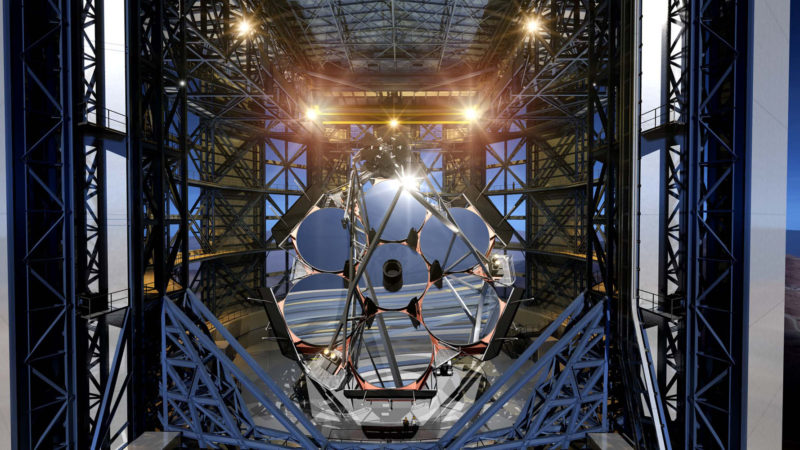Giant Magellan Telescope’s International Partners Approve Start of Construction Phase
The Giant Magellan Telescope Organization has announced today (Wednesday, June 3) that its 11 international partners — including Texas A&M University — have committed more than US$500 million to begin construction of the first of a new generation of extremely large telescopes. Once it is built, the Giant Magellan Telescope (GMT) is poised to be the largest optical telescope in the world.
The Giant Magellan Telescope’s seven mirrors span 25 meters and will focus more than six times the amount of light of the current largest optical telescopes into images up to 10 times sharper than those of the Hubble Space Telescope. The GMT will enable astronomers to look deeper into space and further back in time than ever before. The telescope is expected to see first light in 2021 and be fully operational by 2024.
“The GMT will herald the beginning of a new era in astronomy,” said Wendy Freedman, chair of the Giant Magellan Telescope Organization (GMTO) Board of Directors and University Professor of Astronomy & Astrophysics at the University of Chicago. “It will reveal the first objects to emit light in the universe, explore the mysteries of dark energy and dark matter, and identify potentially habitable planets in the Earth’s galactic neighborhood. The decision by the GMTO partner institutions to start construction is a crucial milestone on our journey to making these amazing discoveries using state-of-the-art science, technology and engineering.”
Described as being “predicated on modern technology,” the GMT will merge lasers with an adaptable optics system that hinges on state-of-the-art astronomical instrumentation, including first-light devices and measurement systems being built and assembled within Texas A&M’s Munnerlyn Astronomical Instrumentation Laboratory.
“The start of construction of the GMT is a major milestone for our program, and we are excited by the opportunity to build instruments for the first of the next generation of telescopes,” said Texas A&M astronomer and GMTO Board Member Darren DePoy, Munnerlyn Lab director and deputy director of the George P. and Cynthia Woods Mitchell Institute for Fundamental Physics and Astronomy. “The spectrograph will enable key capabilities like the study of the most distant galaxies and stars in the universe, determination of the atmospheric composition of exoplanets, and investigations into the nature of dark matter and dark energy. At this point, we are focused on creating the best instrument possible.”


GMTO President Edward Moses, a current Texas A&M Institute for Advanced Study (TIAS) Faculty Fellow, said, “The GMT is a global scientific collaboration, with institutional partners in Australia, Brazil, Korea, the United States and in host nation Chile. The construction approval means work will begin on the telescope’s core structure and the scientific instruments that lie at the heart of this US$1 billion project. Early preparation for construction has included groundwork at the mountaintop site at Las Campanas in northern Chile, and initial fabrication of the telescope’s seven enormous primary mirror segments.”
Professor Matthew Colless, Vice Chair of the Board of Directors and Director of the Research School of Astronomy and Astrophysics at The Australian National University, said the construction approval was an exciting moment for astronomy.
“Plans that have existed only in two dimensions or as computer models are about to become a three-dimensional reality in glass, steel, and high-tech semiconductor and composite materials,” Colless said. “The Giant Magellan Telescope will provide astronomers and astrophysicists with the opportunity to truly transform our view of the universe and our place within it.”
Access the GMTO’s video news package, which includes interviews with GMTO partners and b-roll as well as images and video graphics of the Giant Magellan Telescope.
About the Giant Magellan Telescope
The Giant Magellan Telescope (GMT) is slated to be the first in a new class of extremely large telescopes, capable of producing images with 10 times the clarity of those captured by the Hubble Space Telescope. The GMT aims to discover Earth-like planets around nearby stars and the tiny distortions that black holes cause in the light from distant stars and galaxies. It will reveal the faintest objects ever seen in space, including extremely distant and ancient galaxies, the light from which has been traveling to Earth since shortly after the Big Bang 13.8 billion years ago. The telescope will be built at the Carnegie Institution for Science’s Las Campanas Observatory in the dry, clear air of Chile’s Atacama Desert, in a dome 22 stories high. GMT is expected to see first light in 2021 and be fully operational by 2024.
The telescope’s 25.4-meter (82 feet) primary mirror will comprise seven separate 8.4-meter (27 feet) diameter segments. Each mirror segment weighs 17 tons and takes one year to cast and cool, followed by more than three years of surface generation and meticulous polishing at the Richard F. Caris Mirror Lab of the Steward Observatory of the University of Arizona in Tucson, Ariz. Funding for the project comes from the partner institutions, governments and private donors.
About the Giant Magellan Telescope Organization
The Giant Magellan Telescope Organization (GMTO) manages the GMT project on behalf of its international partners: Astronomy Australia Ltd., The Australian National University, Carnegie Institution for Science, Fundação de Amparo à Pesquisa do Estado de São Paulo, Harvard University, Korea Astronomy and Space Science Institute, Smithsonian Institution, Texas A&M University, The University of Arizona, The University of Chicago, and The University of Texas at Austin.
Connect with the Giant Magellan Telescope Organization on social media: gplus.to/gmtelescope, twitter.com/GMTelescope, facebook.com/GMTelescope and visit http://www.gmto.org.
Watch brief interviews with various GMTO administrators here via You Tube:
-aTm-
MEDIA CONTACTS
Jacqueline Efron, 650-801-0942 or jacqueline.efron@zenogroup.com
Steve Koppes, 773-702-8366 or skoppes@uchicago.edu
Davin Malasarn, 626-204-0529 or dmalasarn@gmto.org
BUSINESS CONTACTS
Edward Moses, (+1) 626-204-0555
Wendy Freedman, (+1) 773-834-5651
Matthew Colless, (+61) 2-6125-0266
The post Giant Magellan Telescope’s International Partners Approve Start of Construction Phase appeared first on College of Science
